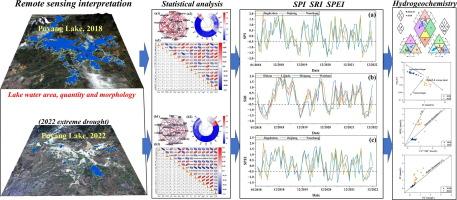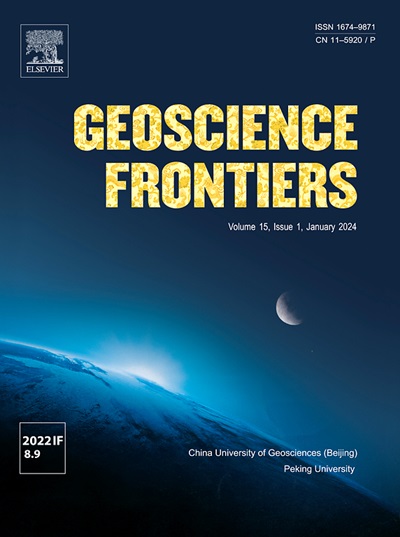极端干旱影响湖泊水质、水量和形态:2022年全球干旱下中国最大淡水湖的证据
IF 8.9
1区 地球科学
Q1 GEOSCIENCES, MULTIDISCIPLINARY
引用次数: 0
摘要
极端干旱对人类构成重大威胁。2022年夏季,全球经历了近年来最严重的干旱,降水不足,气温异常高,深刻影响了人类生活和水生环境。然而,干旱对大型淡水湖的影响尚不清楚。本研究以中国最大的淡水湖鄱阳湖为研究对象,对2018年(正常季节)和2022年(极端干旱期)的湖泊水域面积、数量、湖泊形态和水质进行了调查。结果表明:2022年夏季,标准化降水指数(SPI)、标准化径流指数(SRI)和标准化降水-蒸散指数(SPEI)达到中至重度干旱;2018 - 2022年,湖泊水域面积减少1789.62 km2,水量减少15.40 × 109 m3,湖泊岸线减少2923.70 km。岸线发育指数、尺度比和能量因子分别下降4.87、198.53 m和963.60 m。动态比、相对深度和Schindler’s比分别增加了1457.10、0.04和13.48 m−1。水化学指标在两年内变化显著,2018 - 2022年水化学类型由SO4·Cl - Ca·Mg型和HCO3 - Ca·Mg型转变为SO4·Cl - Ca·Mg型。水岩相互作用、交替阳离子吸附和人为对水质的影响在两个时期表现出不同的模式。研究结果表明,中国最大的淡水湖在普通干旱和极端干旱条件下的水资源和水质存在显著差异,为气候变化对国际大型淡水湖的影响研究提供了参考。本文章由计算机程序翻译,如有差异,请以英文原文为准。

Extreme drought affects lake water quality, quantity, morphometry: Evidence from China’s largest fresh water lake under the 2022 global drought
Extreme drought poses a significant threat to humanity. In the summer of 2022, the world experienced the worst drought in recent years, with a precipitation deficit and an abnormal high temperature, profoundly affecting human life and the aquatic environment. However, the drought influence on large freshwater lakes remains unclear. In this study, we selected China’s largest freshwater lake (Poyang Lake) as the research object and investigated the lake water area, quantity, lake morphology and water quality in 2018 (normal season) and 2022 (extreme drought period). Results showed that standardized precipitation index (SPI), standardized runoff index (SRI) and standardized precipitation-evapotranspiration index (SPEI) reached moderate to severe drought in the summer of 2022. From 2018 to 2022, lake water area decreased (1789.62 km2), water quantity reduced (15.40 × 109 m3) and lake shoreline decreased (2923.70 km). The shoreline development index, size ratio and energy factor decreased by 4.87, 198.53 m and 963.60, specifically. The dynamic ratio, relative depth and Schindler’s ratio increased by 1457.10, 0.04 and 13.48 m−1, respectively. The water chemical indicators varied significantly in two years and the water hydrochemical types changed from SO4·Cl − Ca·Mg type and HCO3 − Ca·Mg type to SO4·Cl − Ca·Mg type from 2018 to 2022. Water-rock interaction, alternating cation adsorption and anthropogenic influence on water quality represented different patterns in two periods. Our findings demonstrate significant differences in water resources and quality between common and extreme drought conditions in China’s largest fresh water lake, which can inform research on climate change effects on international large freshwater lakes.
求助全文
通过发布文献求助,成功后即可免费获取论文全文。
去求助
来源期刊

Geoscience frontiers
Earth and Planetary Sciences-General Earth and Planetary Sciences
CiteScore
17.80
自引率
3.40%
发文量
147
审稿时长
35 days
期刊介绍:
Geoscience Frontiers (GSF) is the Journal of China University of Geosciences (Beijing) and Peking University. It publishes peer-reviewed research articles and reviews in interdisciplinary fields of Earth and Planetary Sciences. GSF covers various research areas including petrology and geochemistry, lithospheric architecture and mantle dynamics, global tectonics, economic geology and fuel exploration, geophysics, stratigraphy and paleontology, environmental and engineering geology, astrogeology, and the nexus of resources-energy-emissions-climate under Sustainable Development Goals. The journal aims to bridge innovative, provocative, and challenging concepts and models in these fields, providing insights on correlations and evolution.
 求助内容:
求助内容: 应助结果提醒方式:
应助结果提醒方式:


